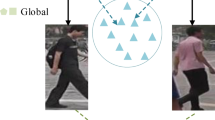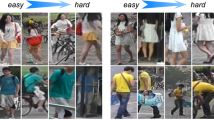Abstract
Existing methods mainly assign pseudo labels by clustering algorithms to solve the problems in domain adaptive pedestrian re-identification caused by unlabeled target domain data and scene style differences between the source and the target domains. But clustering algorithms with single network may generate incorrect noisy pseudo labels which affects the effectiveness of domain adaptation. To address this problem, the dual-branch teacher-student networks uses two networks with almost the same structures to assign soft pseudo labels. However, the soft pseudo labels assigned are largely the same because of the similar structure of the dual networks, which may lead to the same result with single-network training. Therefore, this paper proposes the discrepant mutual learning fusion network to improve the performance of unsupervised domain adaptive person re-identification by both increasing the difference between dual networks and enhancing their feature expressiveness. Firstly, this paper proposes the discrepant dual-branch network (DDNet) to mine the global and local features of the network by constructing two branches with different depths, and constructs the feature random scaling (FRS) module to further enhance the diversity of the extracted feature. Secondly, the feature fusion (FF) module is built to fuse the discrepant features generated by DDNet, and achieve mutual supervise learning of the fusion classification results, which enhances the ability of network feature expression. Experiments show that the proposed method outperforms most classical domain adaptive methods in recognition accuracy.









Similar content being viewed by others
References
Li R., Zhang B., Teng Z. (2021) A divide-and-unite deep network for person re-identification. Appl Intell 51:1479–1491
Yan J., Fan Z., Chen S. (2020) In-depth exploration of attribute information for person re-identification. Appl Intell 11:3607–3622
Luo H., Jiang W., Gu Y., Liu F., Liao X. (2020) A strong baseline and batch normalization neck for deep person re-identication. IEEE Transactions on Multimedia 22:2597–2609
Quan R., Dong X., Wu Y., Zhu L., Yang Y. (2019) Auto-reid: Searching for a part-aware convnet for person re-identication. In: IEEE/ CVF International Conference on Computer Vision (ICCV), pp 3749–3758
Yang G, Ding M., Zhang Y., Zhong H. (2021) Bi-directional class-wise adversaries for unsupervised domain adaptation, Appl Intell, 6615–6622
Zhang X., Cao J., Shen C., You M. (2019) Self-training with progressive augmentation for unsupervised cross-domain person re-identication, International Conference on Computer Vision (ICCV), 8221–8230
Yang F., Wei Y., Wang G., Zhou Y., Shi H, Huang T. (2019) Self-similarity grouping: A simple unsupervised cross domain adaptation approach for person re-identication IEEE/CVF International Conference on Computer Vision (ICCV), pp 6111-6120
Yang F., Li K., Zhong Z., Luo Z., Sun X., Cheng H., Guo X., Huang F. (2020) Asymmetric co-teaching for unsupervised cross-domain person re-identication. In: 34th AAAI Conference on Artificial Intelligence Asymmetric co-teaching for unsupervised cross-domain person re-identication 34th AAAI Conference on Artificial intelligence pp 12597-12604
Fan H., Zheng L., Yan C., Yang Y. (2018) Unsupervised Person Re-identication:, Clustering and Fine-tuning. ACM Transactions on Multimedia Computing 14:1–18
Ge Y., Chen D., Li H. (2020) Mutual mean-teaching: Pseudo label refinery for unsupervised domain adaptation on person re-identication, Computer Vision and Pattern Recognition
Duan L., Xiong D., Lee J., Guo F. (2006) A local density based spatial clustering algorithm with noise. In: IEEE International Conference on Systems, Man and Cybernetics, pp 4061–4066
Pang Z., Guo J., Sun W., Xiao Y., Yu M. (2021) Cross-domain person re-identification by hybrid supervised and unsupervised learning Applied Intelligence
Wu G, Zhu X, Gong X (2020) Tracklet Self-Supervised Learning for Unsupervised Person re-identification. The Thirty-Fourth AAAI Conference on Artificial Intelligence 34:12362–12369
Sun J., Jung C. (2019) Unsupervised person re-identification using reliable and soft labels. In: IEEE international conference on acoustics, speech and signal processing (ICASSP), pp 3007–3011
Zhang B., Qian J. (2021) Autoencoder-based unsupervised clustering and hashing. Appl Intell 51:493–505
Lin Y., Dong X., Zheng L., Yan Y. (2019) A Bottom-Up clustering approach to unsupervised person Re-Identification. The Thirty-Third AAAI Conference on Artificial Intelligence 33:8738– 8745
Chong Y, Peng C., Zhang J., Pan S. (2021) Style transfer for unsupervised domain-adaptive person re-identication. Neurocomputing 422:314–321
Zhu J., Park T., Isola P., Efros A. (2017) Unpaired image-to-image translation using cycle-consistent adversarial networks. In: IEEE Inter-national Conference on Computer Vision (ICCV), pp 2242-2251
Wei L., Zhang S., Gao W., Tian Q. (2018) Person transfer gan to bridge domain gap for person re-identication. In: IEEE/CVF Conference on Computer Vision and Pattern Recognition, pp 79–88
Deng W., Zheng L., Ye Q., Kang G., Yang Y., Jiao J. (2018) Image-image domain adaptation with preserved self-similarity and domain-dissimilarity for person re-identication. In: IEEE/CVF Conference on Computer Vision and Pattern recognition pp 994–1003
Long M., Cao Y., Cao Z., Wang J., Jordan M. (2019) Transferable representation learning with deep adaptation networks. IEEE transactions on pattern analysis and machine intelligence 41(12):3071–3085
Lv J., Chen W., Li Q., Yang C. (2018) Unsupervised cross-dataset person re-identication by transfer learning of spatial-temporal patterns. In: IEEE/CVF Conference on Computer Vision and Pattern recognition pp 7948-7956
Wang J., Zhu X., Gong S., Li W. (2018) Transferable joint attribute-identity deep learning for unsupervised person re-identication. In: IEEE/CVF Conference on Computer Vision and Pattern recognition, pp 2275-2284
Mingote V., Miguel A., Ribas D., Ortega A., Lleida E. (2018) Knowledge distilla- tion and random erasing data augmentation for text-dependent speaker verication . In: IEEE International Conference on Acoustics Speech and Signal Processing (ICASSP), pp 6824–6828
Dai Z., Chen M., Gu X., Zhu S., Tan P. (2019) Batch dropblock network for person re-identication and beyond. In: IEEE/CVF International Conference on Computer Vision (ICCV), pp 3690–3700
Wang W., Zhao F., Liao S., Shao L. (2020) Attentive waveblock: Complementarity-enhanced mutual networks for unsupervised domain adaptation in person re-identication
He K., Zhang X, Ren S. (2016) Deep residual learning for image recognition. In: IEEE conference on computer vision and pattern recognition (CVPR), pp 770–778
Szegedy C., Vanhoucke V., Ioffe S., Shlens J., Wojna Z. (2016) Rethinking the inception architecture for computer vision. In: IEEE Conference on Computer Vision and Pattern Recognition (CVPR), pp 2818–2826
Sun Y., Zheng L., Yang Y., Tian Q., Wang S. (2018) Beyond part models: Person retrieval with refined part pooling (and A strong convolutional baseline). In: European Conference on Computer Vision (ECCV), pp 201–518
Hermans A., Beyer L., Leibe B. (2017) In defense of the triplet loss for person re-identification
Fernando B., Fromont E., Muselet D., Sebban M. (2012) Discriminative feature fusion for image classication. In: IEEE Conference on Computer Vision and Pattern Recognition, pp 3434–3441
Qin J., Huang Y., Wen W. (2020) Multi-scale feature fusion residual network for single image super-resolution. Neurocomputing 379:334–342
Tarvainen A., Valpola H. (2017) Mean teachers are better role models: Weight- averaged consistency targets improve semi-supervised deep learning results, Advances in Neural Information Processing Systems, 1195–1204
Hinton G.E., Vinyals O., Dean J. (2015) Distilling the knowledge in a neural network. Computer Science 14:38–39
Erven T., Harremos P. (2014) Rényi Divergence and Kullback-Leibler Divergence. IEEE Trans Inf Theory 60:3797– 3820
Ristani E., Solera F., Zou R.S., Cucchiara R., Tomasi C. (2016) Performance measures and a data set for multi-target, multi-camera tracking. In: European Conference on Computer Vision (ECCV), pp 17-35
Zheng L., Shen L., Tian L., Wang S., Wang J., Tian Q. (2015) Scalable person re- identication: a benchmark. In: IEEE International Conference on Computer Vision (ICCV), pp 1116–1124
Deng J., Dong W., Socher R., Li L.J., Li K., Li F. (2009) Imagenet: A large-scale hierarchical image database. In: IEEE Conference on Computer Vision and Pattern Recognition, pp 248– 255
Zhong Z., Zheng L., Luo Z., Li S., Yang Y. (2019) Invariance matters: Exemplar Memory for Domain Adaptive Person Re-Identification. In: IEEE/CVF Conference on Computer Vision and Pattern Recognition (CVPR), pp 598-607
Chong Y., Peng C., Zhang C., et al. (2021) Learning domain invariant and specific representation for cross-domain person re-identification. Appl Intell 51:1–14
Bai Y., Wang C., Lou Y., et al. (2021) Hierarchical Connectivity-Centered Clustering for Unsupervised Domain Adaptation on Person Re-Identification. IEEE Transactions on Image Processing 30:6715–6729
Zheng K., Liu W., He L., Mei T., Luo J. (2021) Group-aware Label Transfer for Domain Adaptive Person Re-identification. In: IEEE/CVF Conference on Computer Vision and Pattern Recognition (CVPR), Nashville, TN, USA, pp 5306–5315
Zheng Y., Tang S., Teng G., Ge Y. (2021) Online Pseudo Label Generation by Hierarchical Cluster Dynamics for Adaptive Person Re-identification. In: IEEE/CVF International Conference on Computer vision(ICCV)
Isobe T., Li D., Tian L., et al. (2021) Towards Discriminative Representation Learning for Unsupervised Person Re-identification. In: IEEE/CVF International Conference on Computer vision(ICCV)
Lin Y., Dong X., Zheng L., Yan Y., Yang Y. (2021) A bottom-up clustering approach to unsupervised person re-identification. Inproceedings of the AAAI Conference on Artificial Intelligence 33:8738–8745
Wu G., Zhu X., Gong S. (2021) Tracklet self-supervised learning for unsupervised person reidentification, In AAAI vol. 34, pp. 12362-123699
Wang D., Zhang S. (2020) Unsupervised person reidentification via multi-label classification. In: In 2020 IEEE/CVF Conference on Computer Vision and Pattern Recognition (CVPR), pp 10978–10987
Zeng K., Ning M., Wang Y., Guo Y. (2020) Hierarchical Clustering With Hard-Batch Triplet Loss for Person Re-Identification,2020. In: IEEE/CVF Conference on Computer Vision and Pattern Recognition (CVPR), Seattle, WA USA, pp 13654–13662
Ge Y., Chen D., Zhu F., et al. (2020) Self-paced Contrastive Learning with Hybrid Memory for Domain Adaptive Object re-ID
Zhai Y., Lu S., Ye Q., et al. (2020) AD-Cluster: Augmented Discriminative Clustering for Domain Adaptive Person Re-Identification. In: IEEE/CVF Conference on Computer Vision and Pattern Recognition (CVPR), Seattle, WA, USA, pp 9018–9027
Feng H., Chen M., Hu J., Shen D., Liu H., Cai D. (2021) Complementary Pseudo Labels for Unsupervised Domain Adaptation On Person Re-Identification. IEEE Transactions on Image Processing 30:2898–2907
Zhao. F, Liao. S, Xie. G, et al. (2020) Unsupervised domain adaptation with noise resistible mutual-training for person re-identification. In: European conference on computer vision (ECCV), pp 526–544
Acknowledgements
This work is supported by the Natural National Science Foundation of China (61902404, 51734009, 61771417, 61873246), and the State Key Research Development Program (2016YFC0801403).
Author information
Authors and Affiliations
Corresponding author
Additional information
Publisher’s note
Springer Nature remains neutral with regard to jurisdictional claims in published maps and institutional affiliations.
Rights and permissions
About this article
Cite this article
Yun, X., Wang, Q., Cheng, X. et al. Discrepant mutual learning fusion network for unsupervised domain adaptation on person re-identification. Appl Intell 53, 2951–2966 (2023). https://doi.org/10.1007/s10489-022-03532-1
Accepted:
Published:
Issue Date:
DOI: https://doi.org/10.1007/s10489-022-03532-1




